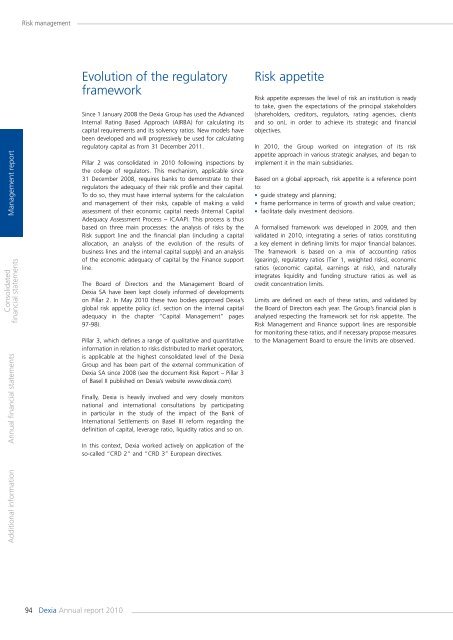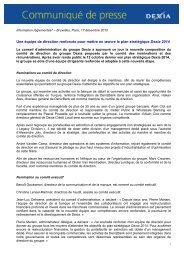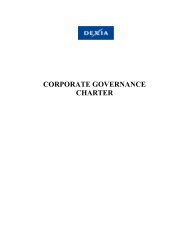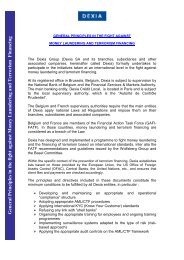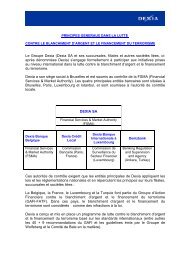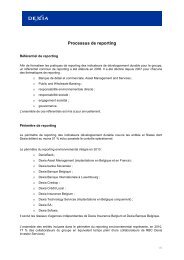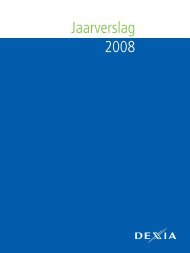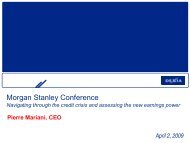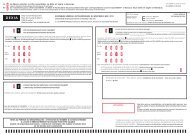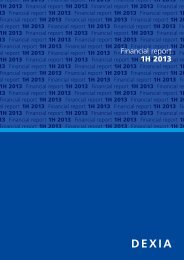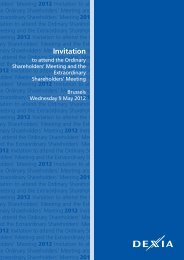Annual report 2010 - Dexia.com
Annual report 2010 - Dexia.com
Annual report 2010 - Dexia.com
- No tags were found...
You also want an ePaper? Increase the reach of your titles
YUMPU automatically turns print PDFs into web optimized ePapers that Google loves.
Risk managementManagement <strong>report</strong>Consolidatedfinancial statementsAdditional information <strong>Annual</strong> financial statementsEvolution of the regulatoryframeworkSince 1 January 2008 the <strong>Dexia</strong> Group has used the AdvancedInternal Rating Based Approach (AIRBA) for calculating itscapital requirements and its solvency ratios. New models havebeen developed and will progressively be used for calculatingregulatory capital as from 31 December 2011.Pillar 2 was consolidated in <strong>2010</strong> following inspections bythe college of regulators. This mechanism, applicable since31 December 2008, requires banks to demonstrate to theirregulators the adequacy of their risk profile and their capital.To do so, they must have internal systems for the calculationand management of their risks, capable of making a validassessment of their economic capital needs (Internal CapitalAdequacy Assessment Process − ICAAP). This process is thusbased on three main processes: the analysis of risks by theRisk support line and the financial plan (including a capitalallocation, an analysis of the evolution of the results ofbusiness lines and the internal capital supply) and an analysisof the economic adequacy of capital by the Finance supportline.The Board of Directors and the Management Board of<strong>Dexia</strong> SA have been kept closely informed of developmentson Pillar 2. In May <strong>2010</strong> these two bodies approved <strong>Dexia</strong>’sglobal risk appetite policy (cf. section on the internal capitaladequacy in the chapter “Capital Management” pages97-98).Pillar 3, which defines a range of qualitative and quantitativeinformation in relation to risks distributed to market operators,is applicable at the highest consolidated level of the <strong>Dexia</strong>Group and has been part of the external <strong>com</strong>munication of<strong>Dexia</strong> SA since 2008 (see the document Risk Report – Pillar 3of Basel II published on <strong>Dexia</strong>’s website www.dexia.<strong>com</strong>).Finally, <strong>Dexia</strong> is heavily involved and very closely monitorsnational and international consultations by participatingin particular in the study of the impact of the Bank ofInternational Settlements on Basel III reform regarding thedefinition of capital, leverage ratio, liquidity ratios and so on.In this context, <strong>Dexia</strong> worked actively on application of theso-called “CRD 2” and “CRD 3” European directives.Risk appetiteRisk appetite expresses the level of risk an institution is readyto take, given the expectations of the principal stakeholders(shareholders, creditors, regulators, rating agencies, clientsand so on), in order to achieve its strategic and financialobjectives.In <strong>2010</strong>, the Group worked on integration of its riskappetite approach in various strategic analyses, and began toimplement it in the main subsidiaries.Based on a global approach, risk appetite is a reference pointto:• guide strategy and planning;• frame performance in terms of growth and value creation;• facilitate daily investment decisions.A formalised framework was developed in 2009, and thenvalidated in <strong>2010</strong>, integrating a series of ratios constitutinga key element in defining limits for major financial balances.The framework is based on a mix of accounting ratios(gearing), regulatory ratios (Tier 1, weighted risks), economicratios (economic capital, earnings at risk), and naturallyintegrates liquidity and funding structure ratios as well ascredit concentration limits.Limits are defined on each of these ratios, and validated bythe Board of Directors each year. The Group’s financial plan isanalysed respecting the framework set for risk appetite. TheRisk Management and Finance support lines are responsiblefor monitoring these ratios, and if necessary propose measuresto the Management Board to ensure the limits are observed.94 <strong>Dexia</strong> <strong>Annual</strong> <strong>report</strong> <strong>2010</strong>


